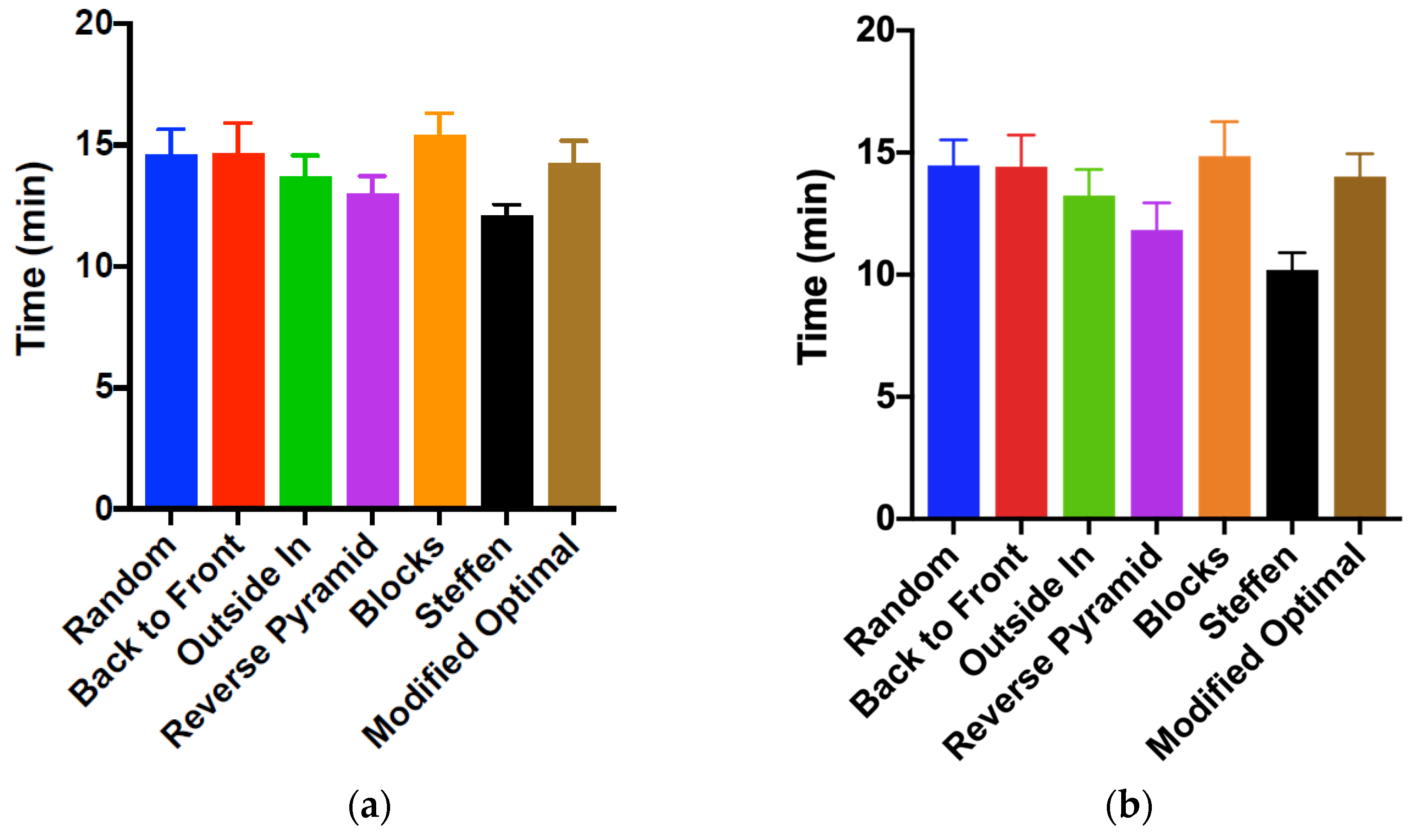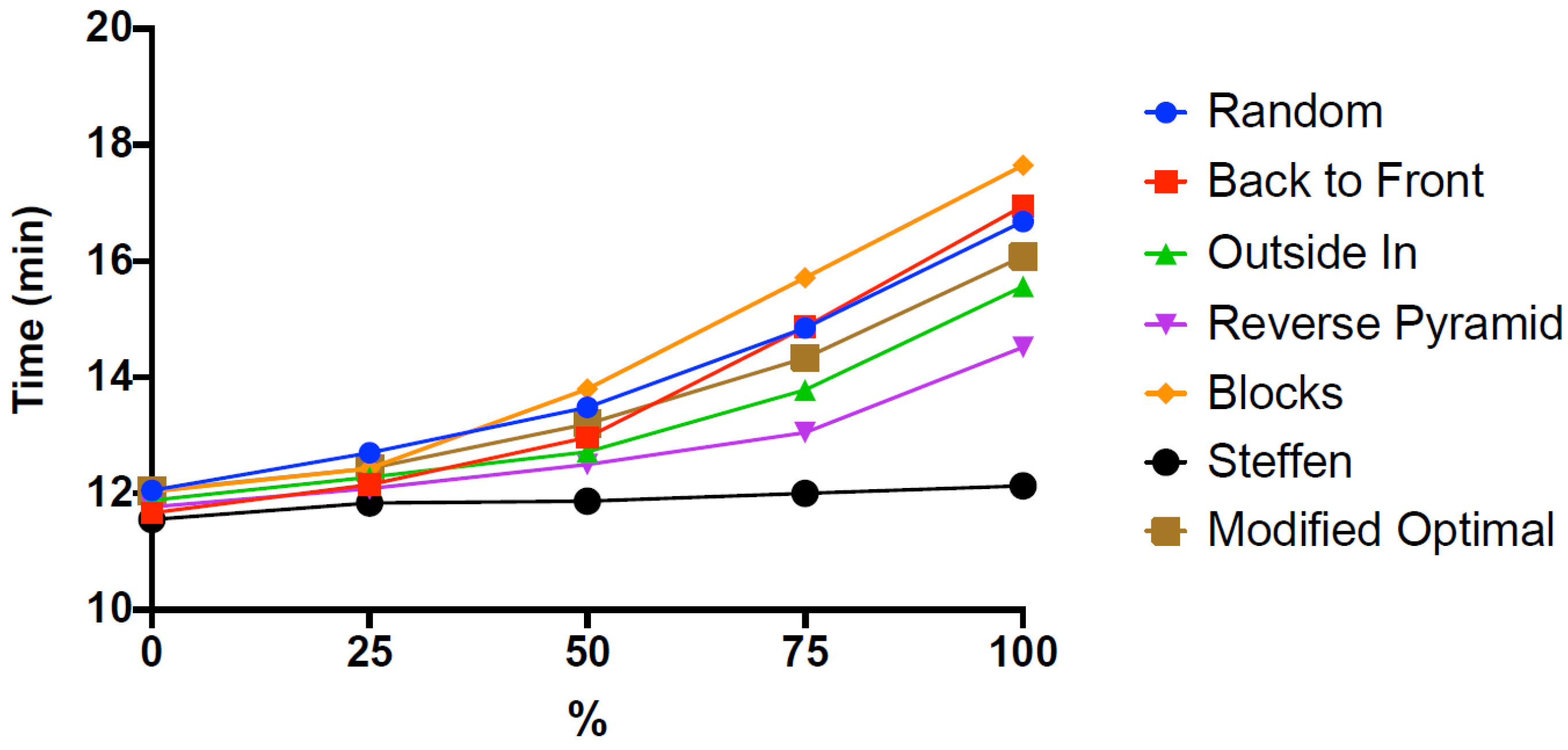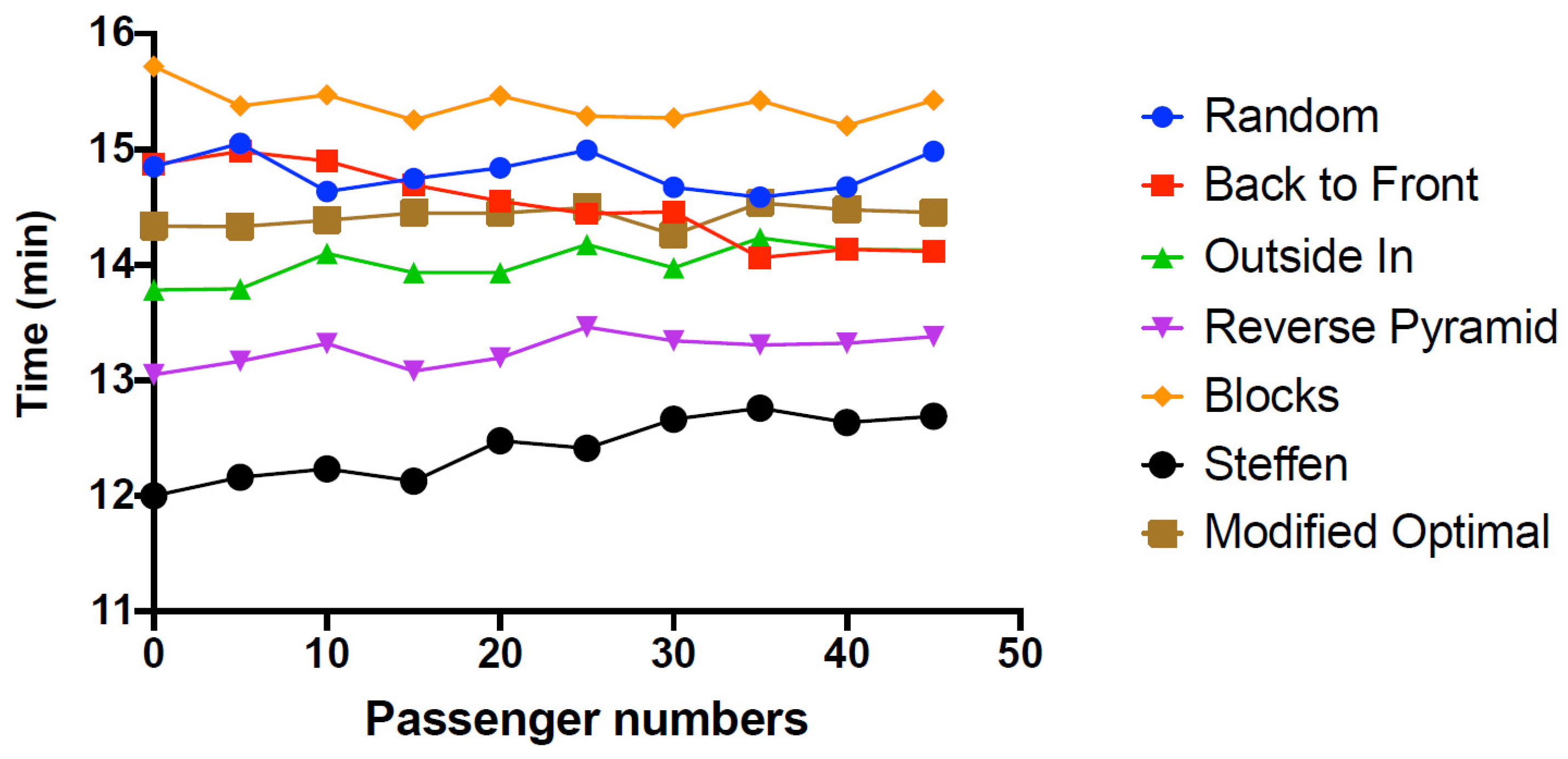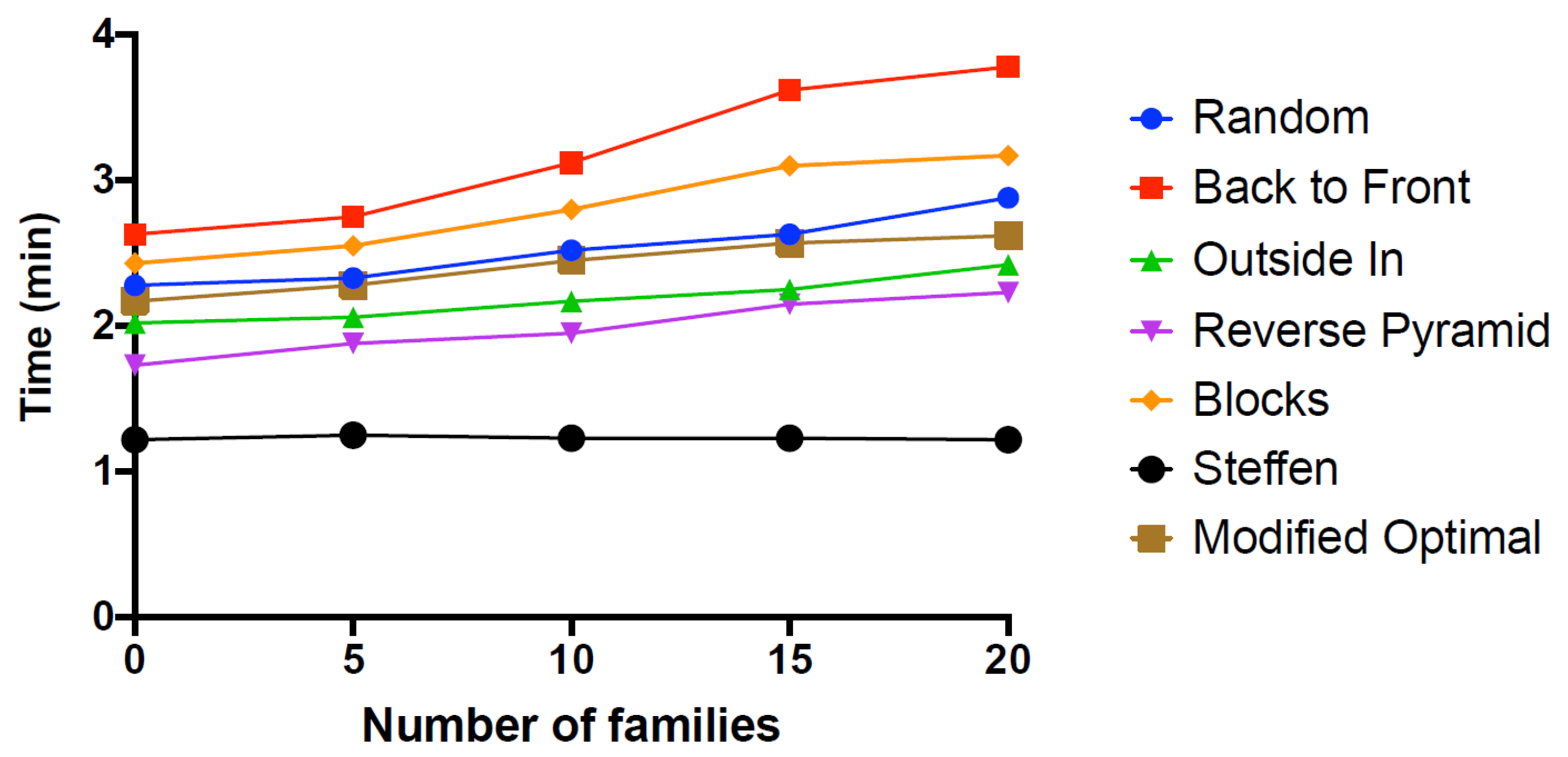A Simulation Study of Aircraft Boarding Strategies
Abstract
:1. Introduction
2. Literature Review
- Random: All passengers belong to a single boarding group, with passengers entering the aircraft randomly, allowing passengers traveling with friends or family members to board together. This approach is often used as a benchmark for other boarding strategies [14].
- Back-to-Front: In this strategy, the first passengers to board are those seated in the last rows of the plane. Boarding continues until the front rows are reached [14]. The back-to-front boarding strategy is usually simplified (to increase practicality) by aggregating rows of seats in blocks.
- Outside-In: In this strategy, the first passengers to board are those who have window seats. They are followed by passengers in the middle seats and, finally, those in the aisle seats. This strategy eliminates seat interference [15].
- Reverse Pyramid: This strategy is a combination of the back-to-front and outside-in strategies. Boarding takes place by allowing the simultaneous entry of passengers from back to front, as well as from the outside inwards. The first passengers to board are those in window seats and those who have middle seats at the rear of the aircraft. Passengers seated in the aisle in the front section of the plane are the last to board. This strategy eliminates seat interference [15].
- Blocks: In this strategy, airplane rows are divided into zones, each of these containing several rows. This strategy first boards passengers in the last rows (zone 1). The passengers who are in the front rows (zone 2) then follow. Subsequently, the order is repeated for the farthest zone (the last unoccupied rows), the front rows, and so on [15].
- Steffen: This strategy implies the call of the passengers one by one to board the airplane. This is carried out from back to front and from the windows to the aisles. Adjacent passengers in each row are seated two rows away from each other in corresponding seats (for example, 12F, 10F, 8F, 6F, 4F, and 2F). Passengers first occupy the even and odd rows on each side of the aircraft cabin, following the order of window seats, then middle seats, and, finally, aisle seats [14].
- Modified Optimal: This method consists of boarding passengers in alternating rows. Passengers are divided into four boarding groups. The first of these consists of all the passengers in even rows but only on one side of the plane. The second group includes all the passengers seated on the other side of the plane. The third and fourth groups are the passengers seated in odd rows on either side of the plane [15].
3. Method
3.1. Model and Parametrization
- Interarrival time: Time interval between passengers entering the boarding gate.
- Hand luggage delay: Time delay required for a passenger to stow their hand luggage in the desired compartment, which may cause aisle interference.
- Seat delay: Time delay caused by type 3 seat interference (refer to Section 2).
3.2. Experimental Setup and Model Validation
4. Simulation Results
4.1. Performance Assessment of Strategies
4.2. Impact of the Percentage of Passengers Carrying Hand Luggage
4.3. Impact of the Number of Priority Passengers
4.4. Impact of the Number of Families
5. Conclusions and Future Research Work
Author Contributions
Funding
Data Availability Statement
Conflicts of Interest
References
- Regnier, E.; Sanchez, S.M.; Sanchez, P.J. Testing-Based Interventions for COVID Pandemic Policies. In Proceedings of the 2020 Winter Simulation Conference, Orlando, FL, USA, 14–18 December 2020; p. 2. Available online: https://informs-sim.org/wsc20papers/074.pdf (accessed on 11 January 2023).
- Sun, X.; Wandelt, S.; Zheng, C.; Zhang, A. COVID-19 pandemic and air transportation: Successfully navigating the paper hurricane. J. Air Transp. Manag. 2021, 94, 102062. [Google Scholar] [CrossRef] [PubMed]
- Milne, R.J.; Delcea, C.; Cotfas, L.-A. Airplane Boarding Methods that Reduce Risk from COVID-19. Safety 2021, 134, 105061. [Google Scholar] [CrossRef] [PubMed]
- IATA. Restarting Aviation Following COVID-19. 2020. Available online: https://www.iata.org/contentassets/f1163430bba94512a583eb6d6b24aa56/covid-medical-evidence-for-strategies-200423.pdf (accessed on 11 February 2021).
- Serter, I.; Clinton, F.; Yarlagadda, P. Agent-based modelling of aircraft boarding methods. In Proceedings of the 4th International Conference on Simulation and Modeling Methodologies, Technologies and Applications (SIMULTECH), Vienna, Austria, 28–30 August 2014; IEEE: Piscataway, NJ, USA, 2014; pp. 148–154. [Google Scholar]
- Schultz, M.; Soolaki, M. Analytical approach to solve the problem of aircraft passenger boarding during the coronavirus pandemic. Transp. Res. Part C Emerg. Technol. 2021, 124, 102931. [Google Scholar] [CrossRef]
- Cotfas, L.A.; Delcea, C.; Milne, R.J.; Salari, M. Evaluating Classical Airplane Boarding Methods Considering COVID-19 Flying Restrictions. Symmetry 2020, 20, 1087. [Google Scholar] [CrossRef]
- Schultz, M.; Fuchte, J. Evaluation of Aircraft Boarding Scenarios Considering Reduced Transmissions Risks. Sustainability 2020, 12, 5329. [Google Scholar] [CrossRef]
- Elcheroth, G.; Drury, J. Collective resilience in times of crisis: Lessons from the literature for socially effective responses to the pandemic. Br. J. Soc. Psychol. 2020, 59, 703–713. [Google Scholar] [CrossRef]
- Walton, J. Will Empty Middle Seats Help Social Distancing on Planes? 2020. Available online: https://www.bbc.com/worklife/article/20200422-when-can-we-start-flying-again (accessed on 11 January 2023).
- Barnett, A.; Fleming, K. COVID-19 Risk Among Airline Passengers: Should the Middle Seat Stay Empty? MedRxiv 2020. [Google Scholar] [CrossRef]
- Soolaki, M.; Mahdavi, I.; Mahdavi-Amiri, N.; Hassanzadeh, R.; Aghajani, A. A new linear programming approach and genetic algorithm for solving airline boarding problem. Appl. Math. Model. 2012, 36, 4060–4072. [Google Scholar] [CrossRef]
- Delcea, C.; Cotfas, L.-A.; Chirita, N.; Nica, I. A Two-Door Airplane Boarding Approach When Using Apron Buses. Sustainability 2018, 10, 3619. [Google Scholar] [CrossRef]
- Steffen, J.; Hotchkiss, J. Experimental test of airplane boarding methods. J. Air Transp. Manag. 2012, 18, 64–67. [Google Scholar] [CrossRef]
- Jafer, S.; Mi, W. Comparative Study of Aircraft Boarding Strategies Using Cellular Discrete Event Simulation. Aerospace 2017, 4, 57. [Google Scholar] [CrossRef]
- Kalic, M.; Markovic, B.; Kuljanin, J. The airline boarding problem: Simulation based approach from different players’ perspective. In Proceedings of the 1st Logistics International Conference, Belgrade, Serbia, 28–30 November 2013; pp. 49–54. [Google Scholar]
- Marelli, S.; Mattocks, G.; Merry, R. The Role of Computer Simulation in Reducing Airplane Turn Time. 1998. Available online: https://www.boeing.com/commercial/aeromagazine/aero_01/textonly/t01txt.html (accessed on 26 October 2020).
- Van Landeghem, H.; Beuselinck, A. Reducing passenger boarding time in airplanes: A simulation based approach. Eur. J. Oper. Res. 2002, 142, 294–308. [Google Scholar] [CrossRef]
- Zeineddine, H. A dynamically optimized aircraft boarding strategy. J. Air Transp. Manag. 2017, 58, 144–151. [Google Scholar] [CrossRef]
- Tang, T.; Wu, Y.H.; Huang, H.; Caccetta, L. An aircraft boarding model accounting for passengers’ individual properties. Transp. Res. Part C Emerg. Technol. 2012, 22, 1–16. [Google Scholar] [CrossRef]
- Ren, X.; Xu, X. Experimental analyses of airplane boarding based on interference classification. J. Air Transp. Manag. 2018, 71, 55–63. [Google Scholar] [CrossRef]
- Bidanda, R.; Winakor, J.; Geng, Z.; Vidic, N. A review of optimization models for boarding a commercial airplane. In Proceedings of the 24th International Conference on Production Research, Poznan, Poland, 30 July–3 August 2017; pp. 1–6. [Google Scholar]
- Jaehn, F.; Neumann, S. Airplane Boarding. Eur. J. Oper. Res. 2015, 244, 339–359. [Google Scholar] [CrossRef]
- Nyquist, D.; McFadden, K. A study of the airline boarding problem. J. Air Transp. Manag. 2008, 14, 197–204. [Google Scholar] [CrossRef]
- Qiang, S.-J.; Jia, B.; Xie, D.-F.; Gao, Z.-Y. Reducing airplane boarding time by accounting for passengers’ individual properties: A simulation based on cellular automaton. J. Air Transp. Manag. 2014, 40, 42–47. [Google Scholar] [CrossRef]
- Kisiel, T. Resilience of passenger boarding strategies to priority fares offered by airlines. J. Air Transp. Manag. 2020, 87, 101853. [Google Scholar] [CrossRef]
- Schultz, M. Dynamic change of aircraft seat condition for fast boarding. Transp. Res. Part C Emerg. Technol. 2017, 85, 131–147. [Google Scholar] [CrossRef]
- Schultz, M.; Soolaki, M.; Salari, M.; Bakhshian, E. A combined optimization–simulation approach for modified outside-in boarding under COVID-19 regulations including limited baggage compartment capacities. J. Air Transp. Manag. 2023, 106, 102258. [Google Scholar] [CrossRef] [PubMed]
- Qureshi, S.M.; Qureshi, H. Exploring the Impact of COVID-19 on Aircraft Boarding Strategies Using Discrete Event Simulation. Oper. Supply Chain. Manag. 2022, 15, 424–440. [Google Scholar]
- Qiang, S.; Huang, Q. New boarding strategies for a novel aircraft cabin installed with side-slip seats. Transp. B Transp. Dyn. 2022, 10, 1010–1031. [Google Scholar] [CrossRef]
- Kobbaey, T.; Bilquise, G.; Naqi, A.A. A Comparative Evaluation of Airplane Boarding Strategies with a Novel Method for Sustainable Air Travel. In Proceedings of the 2023 9th International Conference on Information Technology Trends (ITT), Dubai, United Arab Emirates, 24–25 May 2023; IEEE: Piscataway, NJ, USA, 2023; pp. 169–174. [Google Scholar]
- Withanachchi, O.; Adikariwattage, V. Evaluation of Variability in Boarding Time Under Different Boarding Strategies used for Airline Passenger Boarding Process. J. East. Asia Soc. Transp. Stud. 2022, 14, 2377–2395. [Google Scholar]
- Kobbaey, T.; Bilquise, G. Agent-Based Simulations for Aircraft Boarding: A Critical Review. In ICETIS, Proceedings of the International Conference on Emerging Technologies and Intelligent Systems, Virtual, 2–3 September 2022; Springer International Publishing: Cham, Switzerland, 2022; pp. 42–52. [Google Scholar]
- Tariq, A.; Roosa, K.; Chowell, G. Using Simple Dynamic Analytic Framework to Characterize and Forecast Epidemics. In Proceedings of the 2020 Winter Simulation Conference, Orlando, FL, USA, 14–18 December 2020; IEEE: Piscataway, NJ, USA, 2020; pp. 30–44. [Google Scholar] [CrossRef]
- Ferreira, L.P.; Ares, E.; Peláez, G.; Resano, A.; Luis, C.J.; Tjahjono, B. Simulation of a Closed-Loops Assembly Line. Key Eng. Mater. 2012, 502, 127–132. [Google Scholar] [CrossRef]
- Ramos, A.L.; Ferreira, J.V.; Barceló, J. Modeling & Simulation for Intelligent Transportation Systems. Int. J. Model. Optim. 2012, 2, 274–279. [Google Scholar] [CrossRef]
- Silva, V.; Ferreira, L.P.; Silva, F.J.G.; Tjahjono, B.; Ávila, P. Simulation-Based Decision Support System to Improve Material Flow of a Textile Company. Sustainability 2021, 13, 2947. [Google Scholar] [CrossRef]
- Sá, J.; Ferreira, L.P.; Dieguez, T.; Sá, J.C.; da Silva, F.J.G. Industry 4.0 in the Wine Sector—Development of a Decision Support System Based on Simulation Models. In Innovations in Industrial Engineering, Proceedings of the Icieng 2021, Guimaraes, Portugal, 28–30 June 2021; Machado, J., Soares, F., Trojanowska, J., Ivanov, V., Eds.; Springer: Cham, Switzerland, 2022; pp. 371–384. [Google Scholar] [CrossRef]
- Ferreira, L.P.; Ares, E.; Peláez, G.; Tjahjono, B.; Areal, J.J. Production Planning and Control in an Automobile Closed-Loops Assembly Line. Key Eng. Mater. 2012, 502, 103–108. [Google Scholar] [CrossRef]
- Ferreira, L.P.; Gómez, E.A.; Lourido, G.C.P.; Quintas, J.D.; Tjahjono, B. Analysis and optimisation of a network of closed-loop automobile assembly line using simulation. Int. J. Adv. Manuf. Technol. 2012, 59, 351–366. [Google Scholar] [CrossRef]
- Milne, R.J.; Kelly, A.R. A new method for boarding passengers onto an airplane. J. Air Transp. Manag. 2014, 34, 93–100. [Google Scholar] [CrossRef]
- Steffen, J.H. Optimal boarding method for airline passengers. J. Air Transp. Manag. 2008, 14, 146–150. [Google Scholar] [CrossRef]
- Van Den Briel, M.H.; Villalobos, J.R.; Hogg, G.L.; Lindemann, T.; Mulé, A.V. America west airlines develops efficient boarding strategies. Interfaces 2005, 35, 191–201. [Google Scholar] [CrossRef]
- Milne, R.J.; Salari, M.; Kattan, L. Robust optimization of airplane passenger seating assignments. Aerospace 2018, 5, 80. [Google Scholar] [CrossRef]
- Salari, M.; Milne, R.J.; Kattan, L. Airplane boarding optimization considering reserved seats and passengers’ carry-on bags. Opsearch 2019, 56, 806–823. [Google Scholar] [CrossRef]
- Schultz, M. Field trial measurements to validate a stochastic aircraft boarding model. Aerospace 2018, 5, 27. [Google Scholar] [CrossRef]
- Law, A.M.; Kelton, W.D. Simulation Modeling and Analysis, 5th ed.; McGraw-Hill: New York, NY, USA, 2007. [Google Scholar]
- Banks, J. Introduction to simulation. In Proceedings of the 2000 Winter Simulation Conference, Orlando, FL, USA, 10–13 December 2000; Volume 30067, pp. 9–16. [Google Scholar] [CrossRef]








| Boarding Strategy | Boarding Time p.p. (min) | Boarding Time p.p. with Hand Luggage (min) | Boarding Time p.p. without Hand Luggage (min) | Seating Rate (Passengers/min) |
|---|---|---|---|---|
| Random | 2.28 ± 0.093 * | 2.37 ± 0.092 | 2.06 ± 0.103 | 7.81 |
| Back-to-front | 2.64 ± 0.126 | 2.69 ± 0.119 | 2.37 ± 0.116 | 7.78 |
| Outside-in | 1.85 ± 0.089 | 1.94 ± 0.090 | 1.60 ± 0.091 | 8.32 |
| Reverse-Pyramid | 1.78 ± 0.074 | 1.86 ± 0.072 | 1.55 ± 0.084 | 8.77 |
| Blocks | 2.43 ± 0.079 | 2.48 ± 0.089 | 2.10 ± 0.101 | 7.37 |
| Steffen | 1.22 ± 0.039 | 1.31 ± 0.039 | 0.99 ± 0.044 | 9.48 |
| Modified Optimal | 2.17 ± 0.092 | 2.22 ± 0.091 | 1.87 ± 0.098 | 7.98 |
| Boarding Strategy | All Passengers without Hand Luggage | All Passengers with Hand Luggage | ||
|---|---|---|---|---|
| Boarding Time p.p. (min) | Seating Rate (Passengers/min) | Boarding Time p.p. (min) | Seating Rate (Passengers/min) | |
| Random | 0.64 ± 0.003 * | 9.26 | 3.01 ± 0.070 | 6.86 |
| Back-to-front | 0.64 ± 0.002 | 9.68 | 3.57 ± 0.104 | 6.73 |
| Outside-in | 0.59 ± 0.001 | 9.38 | 2.77 ± 0.077 | 7.35 |
| Reverse-Pyramid | 0.59 ± 0.001 | 9.60 | 2.58 ± 0.082 | 7.92 |
| Blocks | 0.64 ± 0.003 | 9.42 | 3.24 ± 0.085 | 6.46 |
| Steffen | 0.59 ± 0.001 | 9.76 | 1.52 ± 0.047 | 9.49 |
| Modified Optimal | 0.63 ± 0.002 | 9.33 | 2.87 ± 0.065 | 7.10 |
Disclaimer/Publisher’s Note: The statements, opinions and data contained in all publications are solely those of the individual author(s) and contributor(s) and not of MDPI and/or the editor(s). MDPI and/or the editor(s) disclaim responsibility for any injury to people or property resulting from any ideas, methods, instructions or products referred to in the content. |
© 2023 by the authors. Licensee MDPI, Basel, Switzerland. This article is an open access article distributed under the terms and conditions of the Creative Commons Attribution (CC BY) license (https://creativecommons.org/licenses/by/4.0/).
Share and Cite
Moreira, H.; Ferreira, L.P.; Fernandes, N.O.; Silva, F.J.G.; Ramos, A.L.; Ávila, P. A Simulation Study of Aircraft Boarding Strategies. Mathematics 2023, 11, 4288. https://doi.org/10.3390/math11204288
Moreira H, Ferreira LP, Fernandes NO, Silva FJG, Ramos AL, Ávila P. A Simulation Study of Aircraft Boarding Strategies. Mathematics. 2023; 11(20):4288. https://doi.org/10.3390/math11204288
Chicago/Turabian StyleMoreira, Hélio, Luís P. Ferreira, Nuno O. Fernandes, Francisco J. G. Silva, Ana L. Ramos, and Paulo Ávila. 2023. "A Simulation Study of Aircraft Boarding Strategies" Mathematics 11, no. 20: 4288. https://doi.org/10.3390/math11204288





